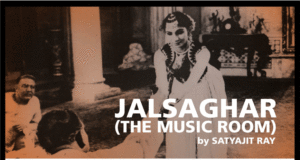Classic Movie Review: Jalsaghar
By Ally Adnan | Movies | Published 7 years ago

Working with a story written by Bengali writer Tarasankar Banerjee, Satyajit Ray tells the melancholic tale of ageing aristocrat, Huzur Biswambhar Roy (Chhabi Biswas), with a lot of heart in Jalsaghar (1958), the best film to emerge from the house of Ray. At once passionate and objective, Jalsaghar is an extremely engaging account of the life of a man desperately clinging to a fading way of life. In addition, the film is a serious study of feudalism and an important discourse on the culture of music in early 20th century Bengal.
The central character, Roy, lives in a large, decaying mansion, along the banks of the river Padma, with his wife Mahamaya (Padma Devi), son Khokha (Pinaki Sengupta) and two servants. The river has eroded his land. He has allowed his finances to dwindle, taken on huge amounts of debt, and seen his income vanish. He makes no effort to reverse his decline and sells the family riches to pay for his unsustainable lifestyle. Music is the only source of pleasure in Roy’s life. He organises lavish recitals in his music room — the titular Jalsaghar — in an effort to conjure the pleasureful days of an affluent past, oblivious to the decay and rot that surrounds him. He resents his neighbour, the nouveau riche Mahim Ganguly (Gangapada Basu), and, in a bid to outdo him, organises increasingly expensive concerts that ultimately prove ruinous for him and his family. His tragic end, alone and penniless, has been all but foretold by his sad life.
Roy is not a likable character. He treats everyone around him — his wife, son, neighbour, servant, and overseer — poorly. He is less a victim of changing times and more one of his own selfish pride, obstinacy and laziness. And although he does not know it, he has paved his own road to perdition. But Ray examines Roy’s life with compassion, occasionally romanticising what is highly destructive behaviour. He makes two judicious modifications to Banerjee’s story, in order to add nuance to Roy’s character and make it less melodramatic. One, he changes the circumstances of the death of Roy’s wife and son to implicate the landlord. And, two, he does away with the illicit relationship between him and danseuse Krishna Bai (Roshan Kumari), making the Pyrrhic victory of the last of the movie’s three concerts more about Ganguly and Roy than anything else.
The film takes place almost entirely inside Roy’s mansion and the open spaces around it. Crumbling yet magnificent, it is a reminder of a past that is vanishing slowly but surely. Ray captures its opposing splendour and degeneration with masterly skill. Thanks to Subrata Mitra’s superb camera work, and Ray’s remarkable sense of space, the languid aura of mise en scène in Jalsaghar is genuinely haunting. The film was shot at a majestic old palace in the village of Nimtita, West Bengal. Ray selected the location after a search that lasted several months and involved visits to 30 palaces. He could not have found a better place to portray a home that becomes both a prison and a refuge for its doomed owner. An integral part of Jalsaghar, the mansion contributes to the unsettling melancholy and mystique of the film. Coincidentally, it was owned, at one time, by landowner Upendra Narayan Choudhury, who was Banerjee’s inspiration for the main character of his story.
Three musical soirees constitute integral parts of Jalsaghar. They are not the gratuitous song and dance sequences seen in most Indian films. Each one helps the narrative highlight key elements of the story, and has its own dramatic significance.
Although full of grand settings and visuals, Jalsaghar is a remarkably austere film. Ray’s gift for making sensitive and perceptive films, free of artifice, is on full display throughout Jalsaghar but especially in two scenes.
In one, Mahamaya bows and touches her husband’s feet before embarking on a journey to see her ailing father. “I’m afraid to leave you alone. There’s no telling what you might do,” she says. “Behave yourself!” Her act of devotion and subsequent admonition perfectly highlight the conflict between the old and the modern that is at the heart of the film and perfectly establishes the dynamics of the relationship between Roy and Mahamaya. In the second scene, Roy’s servant, Ananta (Kali Sarkar), is seen welcoming guests to a concert by sprinkling rosewater on them using a gulab paash. In a gesture of unbridled arrogance, he gives the sprinkler an extra, derisive shake before spraying Ganguly. The contempt for new money is not limited to the aristocratic owner of the mansion; even the servants hold scorn for ways of life that will soon overtake their own.
At the time of the film’s release, Ray was criticised for falling in love with the character of Huzur Biswambhar Roy and the glorious past he represented. Viewers of Jalsaghar may find themselves developing a similar fondness for the flawed hero of the film, finding his inability to deal with the death of his class, his time and his family sadly endearing. A better study of character has rarely, if ever, been done in cinema.


